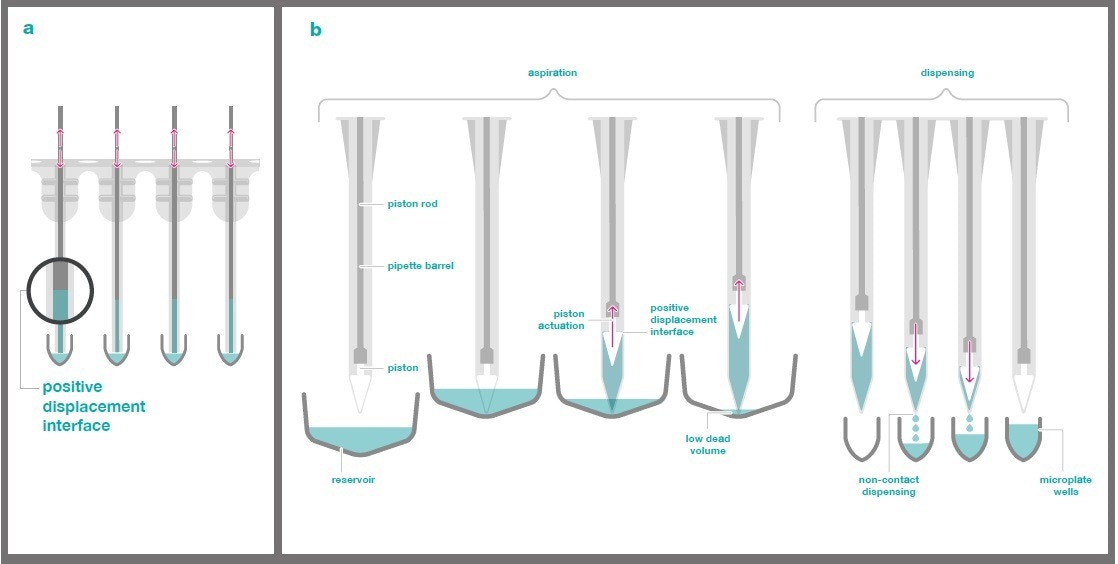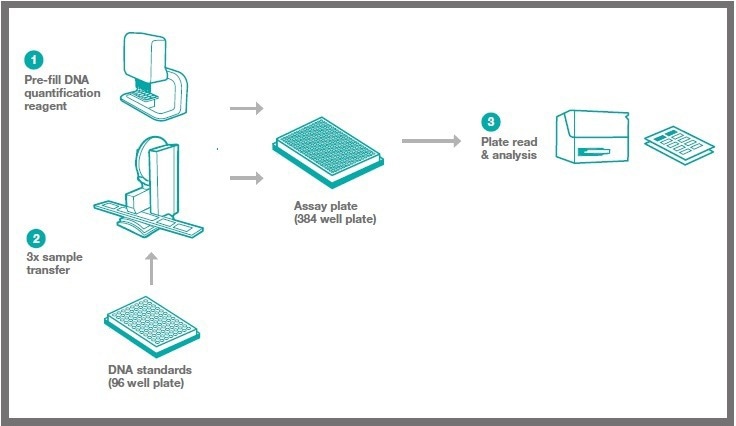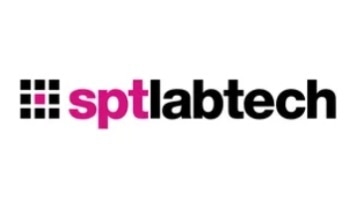The quantification and subsequent normalization of nucleic acids are crucial stages in numerous genomics applications. Typical quantification workflows utilize great volumes of expensive reagents and waste precious DNA. Furthermore, highly viscous DNA samples pose a challenge for automated liquid handling.
Substantial increases in throughput, in combination with decreased reagent expenses and sample savings, can be attained through the use of a dragonfly® discovery dispenser and a mosquito® pipetting robot.
Instruments and pipetting technology
The positive-displacement pipetting technology provided by SPT Labtech facilitates precise and accurate liquid handling, even for the most viscous or volatile liquids.
mosquito LV genomics provides multichannel pipetting in either 8 or 16 channels from 25 nL - 1.2 μL. It facilitates aspiration, dispensing, and mixing, making plate copies and serial dilutions.
dragonfly discovery is a non-contact dispenser that has a dynamic range between 200 nL and 4 mL. It can be equipped with either three, six, or 10 independent dispense heads.
Key benefits
- Assay miniaturization offers a simple method to increase the number of technical replicates whilst minimizing the requirements associated with sample and reagent input.
- Validated for use with the Promega Quantifluor®, Quant-IT™ PicoGreen™ and Biotium AccuClear™ kits
- Excellent assay linearity and reproducibility across the DNA concentration range (0.05 – 20 ng/ml).

Figure 1. A) mosquito tip design: disposable micropipettes with positive displacement pistons. B) dragonfly discovery tip technology: schematic of an aspiration and dispense cycle with a single tip. Image Credit: SPT Labtech
Materials and methods
The sample quantification workflow is displayed in Figure 2 and has the following steps:
- A 384-well assay plate is prefilled with the DNA quantification reagent utilizing the dragonfly discovery.
- Samples are relocated in triplicates from a 96-well plate into the 384-well plate with the use of the mosquito LV genomics.
- The 384-well plate is subsequently scanned with a BMG ClarioStar® reader, and the output results are captured in Excel, ready for normalization.

Figure 2. Workflow schematic for automated, dye-based DNA quantification process. Image Credit: SPT Labtech
Validating miniaturized DNA quantification
The typical dye-based DNA quantification methods such as Quant-iT™ PicoGreen™, Promega’s QuantiFluor®, and Biotium’s AccuClear™ were adapted and utilized.
Protocols were determined for miniaturized high throughput for each kit using only 600 nL of DNA sample in triplicate. The volume of fluorescent dye used was significantly reduced, as shown in Table 1.
Source: SPT Labtech
| |
Final volumes in triplicates |
| Manual volume |
Automated volume |
Savings |
| DNA |
Dye |
DNA |
Dye |
DNA |
Dye |
Promega
QuantiFluor® |
3-60 μL |
200 μL |
600 μL |
10 μL |
Up to 100x |
20x |
Quant-iT™
PicoGreen™ |
<1000 μL |
1000 μL |
600 μL |
10 μL |
Up to 1500x |
100x |
Biotium
AccuClear™ |
30 μL |
200 μL |
600 μL |
50 μL |
50x |
4x |
Samples and reagent input
Table 1 displays the fluorescent dye and DNA sample volumes required for each quantification kit alongside the manual and automated miniaturized protocols.
Results

Figure 3. Standard curves with lambda control DNA; either prepared manually at original reaction volumes as per the manufacturer’s protocol, or with mosquito LV genomics and dragonfly discovery at miniaturized volumes (see Table for details). A) Promega QuantiFluor® B) Biotium AccuClear™ C) Quant-iT™ PicoGreen™. Image Credit: SPT Labtech
Conclusion
This article demonstrates the effectiveness of the combination of mosquito LV genomics and dragonfly discovery for automation and accurate miniaturized DNA quantification using dye-based kits.
This method enables DNA quantification set-up in high throughput. It provides extremely reliable results while minimizing reagent costs and preserving valuable samples.
Exploring miniaturized DNA quantification assays with positive-displacement liquid handlers.
About SPT Labtech
We Design and Manufacture Robust, Reliable and Easy-to-Use Solutions for Life Science
We enable life scientists through collaboration, deep application knowledge, and leading engineering to accelerate research and make a difference together. We offer a portfolio of products within sample management, liquid handling, and multiplexed detection that minimize assay volumes, reduce material handling costs and put the discovery tools back in the hands of the scientist.
At the Heart of What We Do
Many of our innovations have been born out of the desire to create solutions to existing customer problems; and it’s this ethos that drives SPT Labtech’s R&D efforts. Our strengths come from the trust our customers have with us to develop truly unique, automated technologies to meet their needs. We combine cutting edge science with first-rate engineering to put customers at the heart of everything we do.
A Problem-Solving State of Mind
The substantial breadth of expertise within our company enables us to be involved in the full life cycle of our products from the initial design concept, mechanical and software engineering and prototyping, to final manufacture and sale. These qualities allow us to offer the best possible technical and mechanical support to all the equipment that we supply, hence maintaining excellent client relationships.
Sponsored Content Policy: News-Medical.net publishes articles and related content that may be derived from sources where we have existing commercial relationships, provided such content adds value to the core editorial ethos of News-Medical.Net which is to educate and inform site visitors interested in medical research, science, medical devices and treatments.